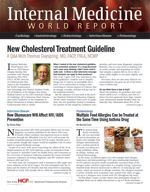Publication
Article
Internal Medicine World Report
Osteoporosis Treatment May Be Useful in Brittle Bone Disease
Author(s):
Although few treatment options are currently available for adult patients with brittle bone disease, a recent study found an anabolic treatment for osteoporosis also increases hip and spine bone mineral density in osteogenesis imperfecta patients, especially those with a milder form of the disorder.

Although few treatment options are currently available for adult patients with brittle bone disease, a study published in the February 2014 issue of the Journal of Clinical Investigation found an anabolic treatment for osteoporosis also increases hip and spine bone mineral density (BMD) in osteogenesis imperfecta (OI) patients, especially those with a milder form of the disorder.
For their study, which was the first trial to examine a bone-growing agent in OI, researchers from medical institutes across the United States randomized 79 adult OI patients to 20 μg of teriparatide (human parathyroid hormone) or placebo for 18 months. To establish endpoints, the investigators used dual-energy X-ray absorptiometry to calculate the change in areal BMD of the lumbar spine, total hip, and femoral neck, and they also measured “change in bone remodeling markers and vertebral volumetric BMD, estimated vertebral strength, and self-reported fractures.”
On measures of bone density and vertebral strength, the authors reported the “change in areal BMD in the teriparatide group was higher than in the placebo group by 5.0% (in total hip), 3.7% (in femoral neck), and 3.3% (in lumbar spine) at 18 months relative to baseline.” In addition, “vertebral volumetric BMD declined in the placebo-treated group, but increased considerably in teriparatide-treated patients,” and the teriparatide group “showed an increase in estimated vertebral strength compared with placebo.”
However, the subjects who had mild forms of OI (type I) benefitted more from teriparatide treatment than those with severe forms of the genetic bone disorder (types III and IV). In fact, the authors said a “test of a 3-way interaction among treatment group, time, and OI type showed that the trend in treatment response in lumbar spine areal BMD over the course of the study was significantly different in patients with type I versus type III/IV OI, (as) areal BMD increased in type I patients, but did not in type III/IV patients.”
“Moreover, interaction analyses demonstrated that type I patients had significant treatment effects at 12 and 18 months, while those with type III/IV had no response at any time point,” the researchers added. “The interaction analysis also showed that type I patients had a more robust response to therapy than type III/IV patients at 18 months.”
In a press release, study author Brendan Lee, MD, of the Baylor College of Medicine in Texas, said that particular finding “rais(es) important questions about how different genetic mutations found in the same gene can respond differently to medications.”
Although the US Food and Drug Administration (FDA) previously approved teriparatide to treat women with osteoporosis by increasing the rate of bone formation, Lee noted that OI is a different disease. And among the few studies that have observed adult OI patients, “the bone density seems to have increased, but the fracture rate has not been reduced significantly,” Lee explained.
Nevertheless, Lee said he “hope(s) that larger studies using this drug will be undertaken to determine whether it can also reduce the risk of fracture.” During his study, 29% of the OI patients randomized to teriparatide self-reported fractures, compared to 36% of the placebo group; however, that difference was not significant.
The trial received funding from the Osteoporosis Imperfecta Foundation, Eli Lilly and Co., the National Center for Advancing Translational Science (NCATS) at the National Institutes of Health (NIH), and the Baylor College of Medicine General Clinical Research Center.





